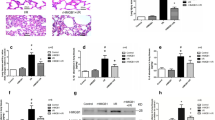Summary
In order to investigate the effects of different terms of inhaled nitric oxide (NO) preconditioning with low concentration on the activations of Toll-like receptor 2 and 4 (TLR2/4) in the lung ischemia-reperfusion (IR) injury in mice, we divided the male C57BL mice into five groups: sham (S) group, IR group, NO 1-min preconditioning group (15 ppm NO inhalation for 1 min before ischemia, NO 1-min), NO 10-min preconditioning group (15 ppm NO inhalation for 10 min before ischemia, NO 10-min), NO 60-min preconditioning group (15 ppm NO inhalation for 60 min before ischemia, NO 60-min). The changes of partial pressure of oxygen in artery (PaO2), left lung wet-to-dry weight ratio (W/D), and myeloperoxidase (MPO) in the injured lung were measured in every group at 6th h of reperfusion after 60 min of left lung ischemia. The changes of TLR2/4 activations and plasma TNF-α were measured in this procedure in additional mice. As compared with IR group, PaO2 increased, MPO and W/D decreased evidently after reperfusion in NO 10-min group. The changes in NO 60-min group were similar to those in NO 10-min group. There was no difference between NO 1-min and IR group. In NO inhalation group, the expressions levels of TLR2/4 mRNA and proteins were diminished, TNF-α concentrations were decreased, and the lung injuries were ameliorated effectively. We concluded that short term inhalation of NO protected lung IR injury. But the protective effect of NO was not increased with extension of inhaled NO. Inhaled NO could inhibit the activations of TLR2/4 in the lung after IR injury. TLR signal pathway might contribute to the effect of protection with NO in this model.
Similar content being viewed by others
References
De Perror M, Liu MY, Waddell TK, et al. Ischemia-reperfusion-induced lung injury. Am J Respir Crit Care Med, 2003,167(4):490–511
Feil R, Lohmanm SM, de Jonge H, et al. Cyclic GMP-dependent protein kinases and the cardiovascular system: insights from genetically modified mice. Circ Res, 2003,93(10):907–916
Tripatara P, Patel NSA, Webb A, et al. Nitrite-derived nitric oxide protects the rat kidney against ischemia/reperfusion injury in vivo: Role for xanthine oxidoreductase. J Am Soc Nephrol, 2007,18(2):570–580
Griffiths MJ, Evans TW. Inhaled nitric oxide therapy in adults. N Engl J Med, 2005,353(25):2683–2695
Foley E, O’Farrell PH. Nitric oxide contributes to induction of innate immune responses to gram-negative bacteria in Drosophila. Genes Dev, 2003,17(1):115–125
Hua F, Ma J, Ha T, et al. Differential roles of TLR2 and TLR4 in acute focal cerebral ischemia/reperfusion injury in mice. Brain Res, 2009,1262:100–108
Hu H, Lu X, Wang F, et al. Activated carbon based selective purification of medical grade NO starting from arc discharge method. Carbon, 2011,1(46):2197–2205
Zheng ZK, Li JS, Wang JJ, et al. Establishment of mouse lung ischemia-reperfusion injury models. Acta Medicinae Universitatis Scientiae Technologiae Huazhong (Chinese), 2011,40(6):727–729
Ware LB, Wang Y, Fang X, et al. Assessment of lungs rejected for transplantation and implications for donor selection. Lancet, 2002,360(9333):619–620
Waldow T, Alexiou K, Witt W, et al. Attenuation of reperfusion-induced systemic inflammation by preconditioning with nitric oxide in an in situ porcine model of normothermic lung ischemia. Chest, 2004,125(6):2253–2259
Watson CM, Reight L, Nottingham JM. Inhaled nitric oxide. Curr Surg, 2005,62(4):396–399
Meade MO, Granton JT, Matte-Martyn A, et al. The Toronto Lung Transplant Program: A randomized trial of inhaled nitric oxide to prevent ischemia-reperfusion injury after lung transplantation. Am J Respir Crit Care Med, 2003,167(11):1483–1489
Waldow T, Witt W, Buzin A, et al. Prevention of ischemia/ reperfusion-induced accumulation of matrix metalloproteinases in rat lung by preconditioning with nitric oxide. J Surg Res, 2009,2(152):198–208
Fehrenbach A, Wittwer T, Meyer D, et al. Nitroglycerin alters alveolar type cell ultrastructure after ischemia II and reperfusion. J Heart Lung Transplant, 2001,20(8):876–888
Ridnour LA, Thomas DD, Mancardi D, et al. The chemistry of nitrosative stress induced by nitric oxide and reactive nitrogen oxide species. Putting perspective on stressful biological situations. Biol Chem, 2004,385(1):1–10
Nagasaka Y, Fernandez BO, Garcia-Saura MF, et al. Brief periods of nitric oxide inhalation protect against myocardial ischemia-reperfusion injury. Anesthesiology, 2008, 109(4):675–682
Bogdan, C. Nitric oxide and the immune response. Nat Immunol, 2001,2(10):907–916
Pålsson-McDermott EM, O’Neill LA. Signal transduction by the lipopolysaccharide receptor, Toll-like receptor-4. Immunology, 2004,113(2):153–162
Wu HS, Zhang L, Chen Y, et al. Effect of nitric oxide on toll-like receptor 2 and 4 gene expression in rats with acute lung injury complicated by acute hemorrhage necrotizing pancreatitis. Hepatobiliary Pancreat Dis Int, 2005,4(4):609–613
Jin X, Wang L, Wu HS. Et al. N-acetylcysteine inhibits activation of toll-like receptor 2 and 4 gene expression in the liver and lung after partial hepatic ischemia-reperfusion injury in mice. Hepatobiliary Pancreat Dis Int, 2007,6(3):284–289
Into T, Inomata M, Nakashima M, et al. Regulation of MyD88-dependent signaling events by S nitrosylation retards Toll-Like receptor signal transduction and initiation of acute-phase immune responses. Mol Cell Biol, 2008,28(4):1338–1347
Author information
Authors and Affiliations
Corresponding author
Additional information
The authors contributed equally to this work.
Rights and permissions
About this article
Cite this article
Zheng, Zk., Wang, Jj., Hu, H. et al. Short-term inhalation of nitric oxide inhibits activations of toll-like receptor 2 and 4 in the lung after ischemia-reperfusion injury in mice. J. Huazhong Univ. Sci. Technol. [Med. Sci.] 33, 219–223 (2013). https://doi.org/10.1007/s11596-013-1100-4
Received:
Published:
Issue Date:
DOI: https://doi.org/10.1007/s11596-013-1100-4




